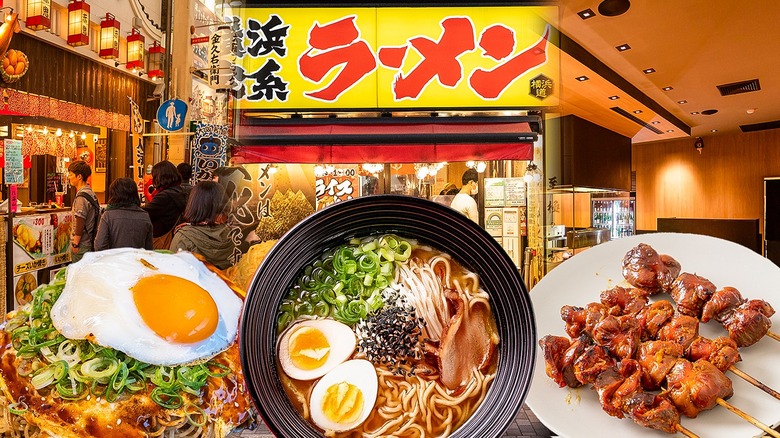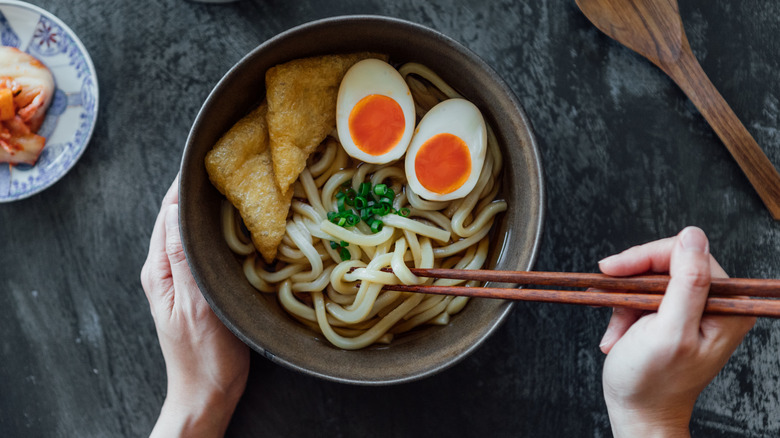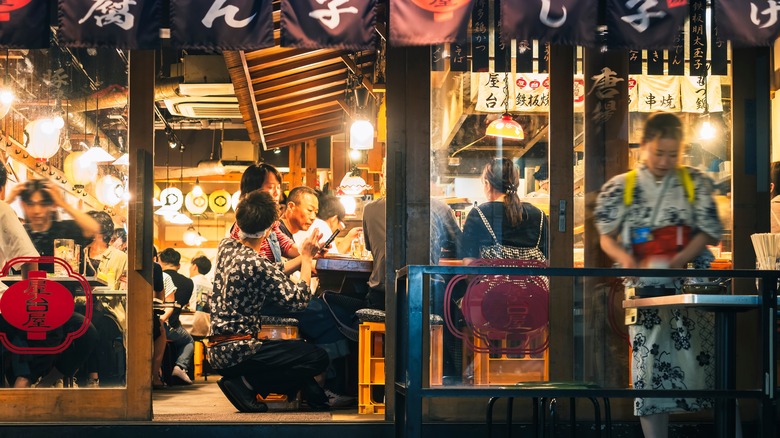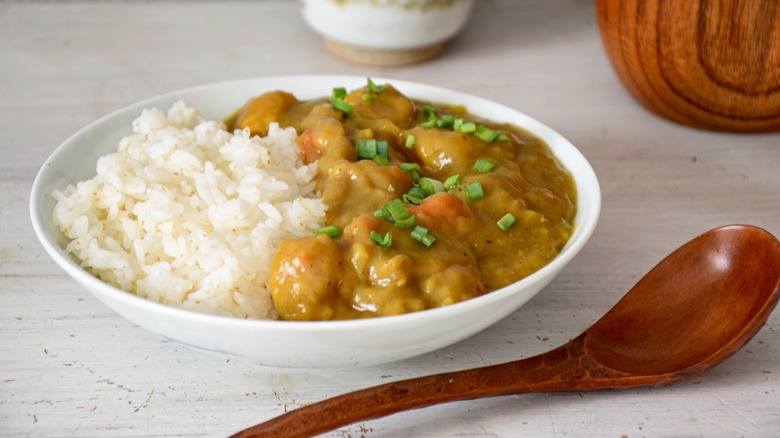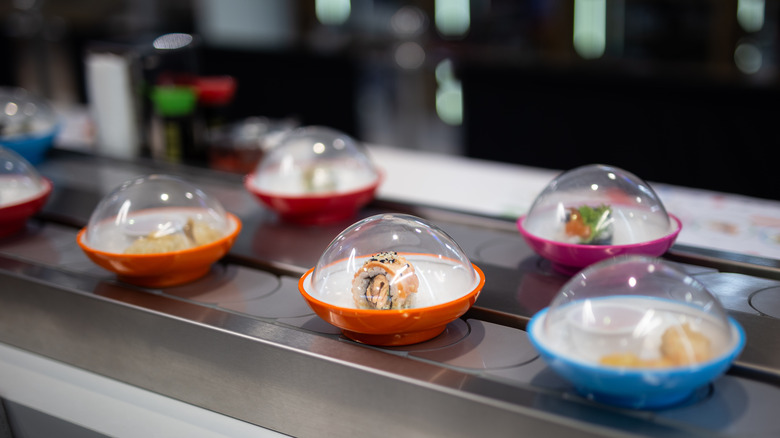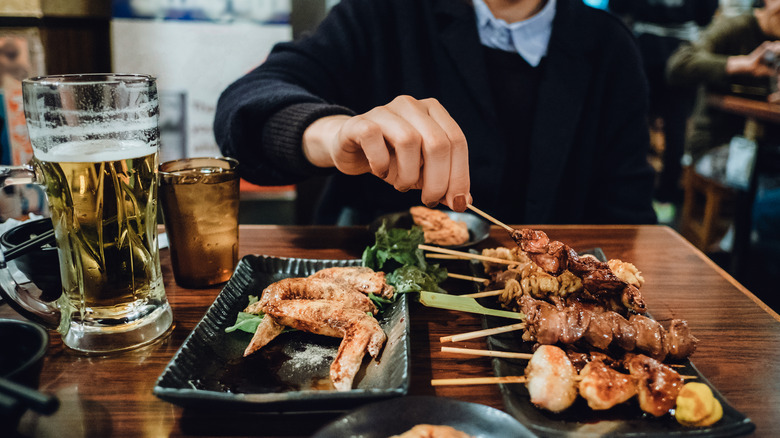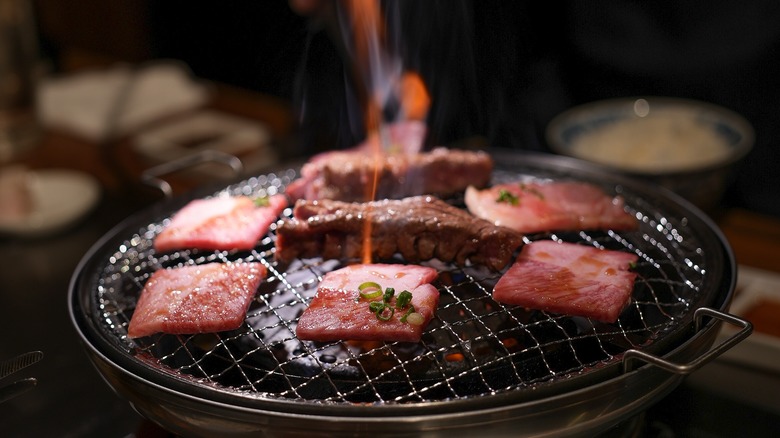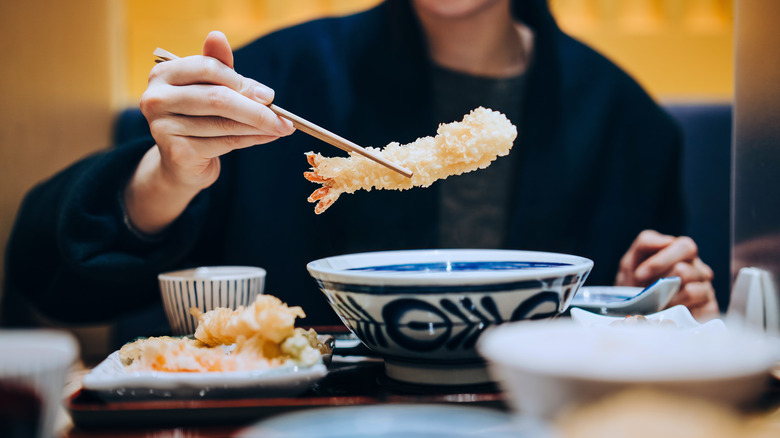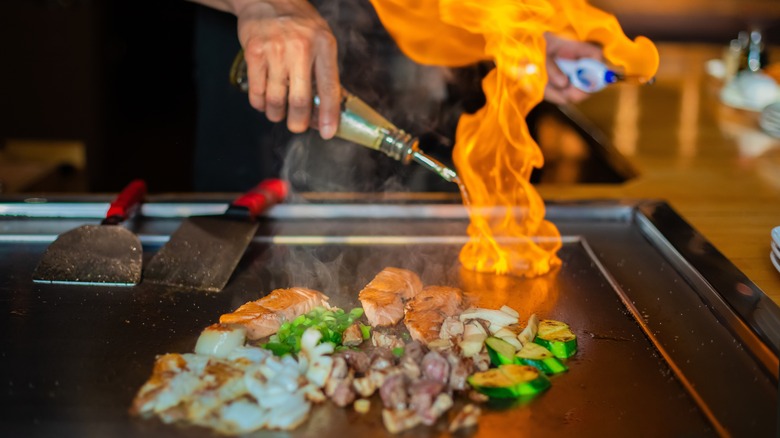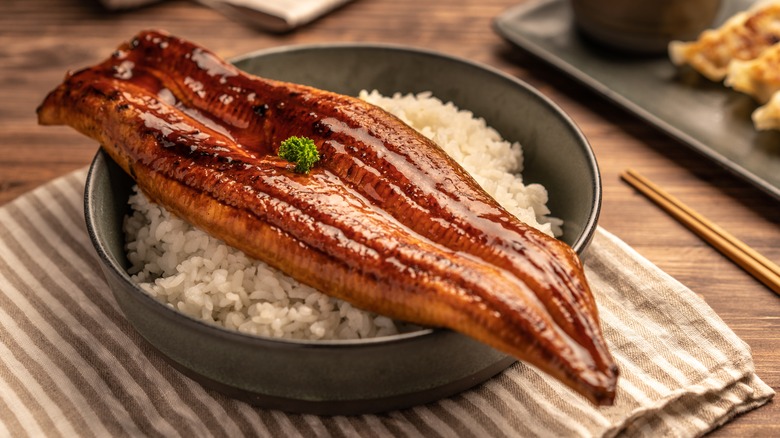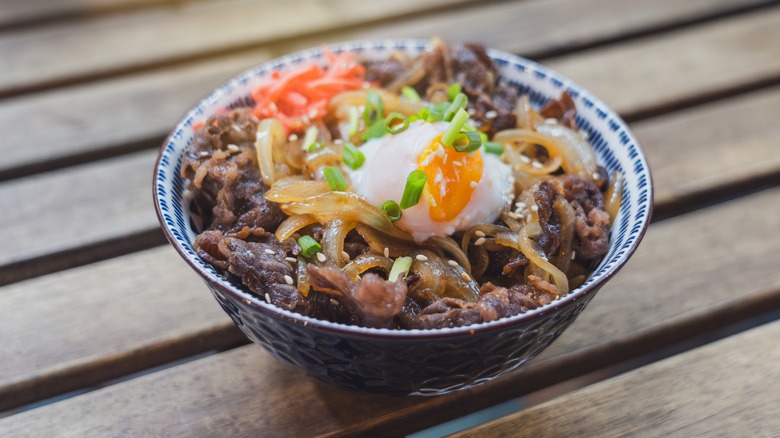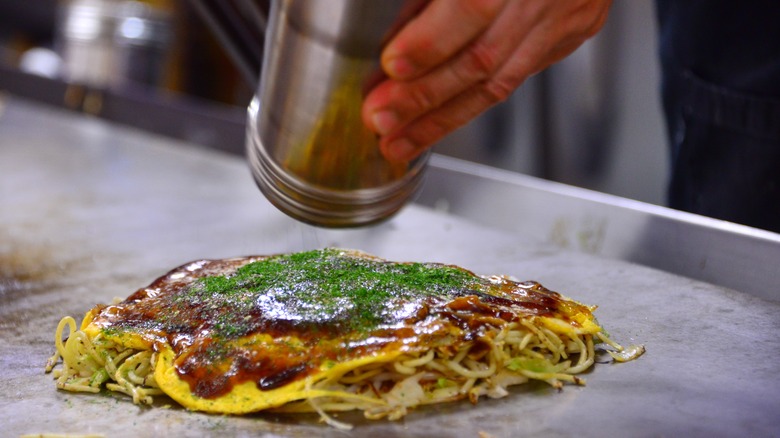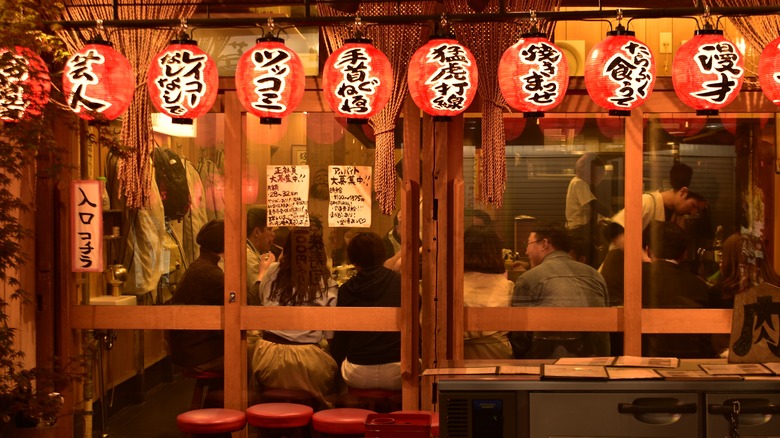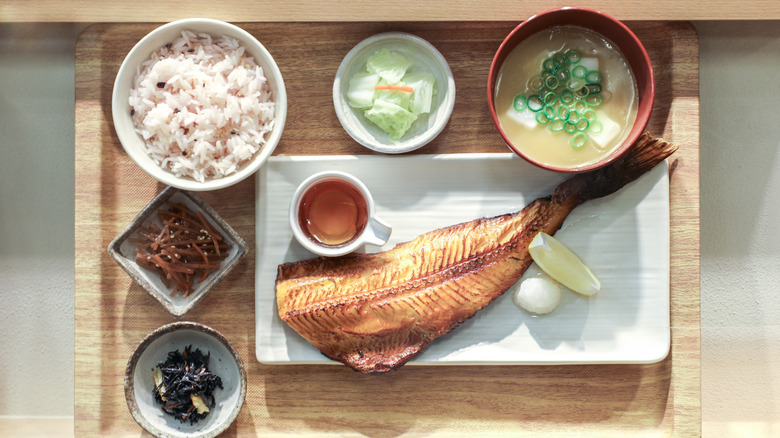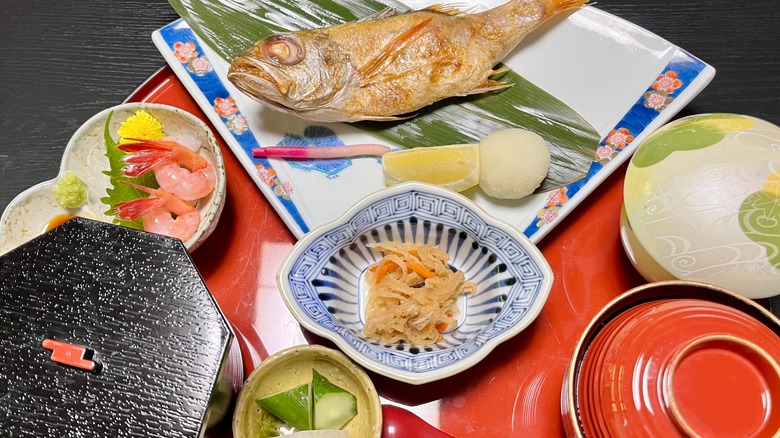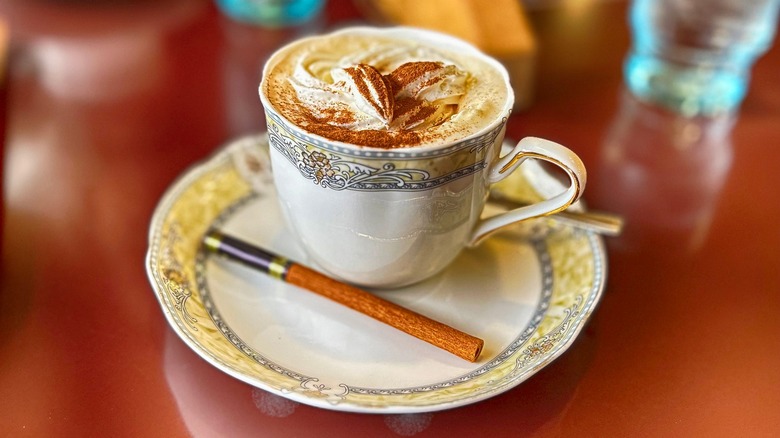15 Types Of Japanese Restaurants, Explained
Japanese cuisine is one the most famous and nutritious foods in the world, featuring both hearty and refined dishes, seducing amateur and seasoned palates alike. Soy sauce, sesame oil, tofu, and nori are some of the most essential ingredients used in typical Japanese cooking, be it sushi rolls, katsudon (pork cutlet and rice), or sukiyaki (beef hot pot with a special broth). Even popular breakfast foods are filling and prepared with care, from the plainest bowl of steamed rice to miso soup, fermented soybeans, and delicately rolled eggs.
Outside of Japan, the United States and China are the two countries that have the most Japanese restaurants, per Statista, with over 26,000 businesses in the U.S. alone. Still, we can't just lump them all into one category, as there are various types of eateries with their specific specialties, crowds, and etiquette. Here's how to tell them apart from one another.
Ramen, soba, and udon
Ramen, soba, and udon-ya ("ya" means "shop" or "restaurant") are some of the most common types of eateries in Japan, serving one or more of these satisfying, versatile, and inexpensive noodles. These dishes are not one and the same, though. A ramen dish is traditionally a bowl of thin, wheat-based noodles swimming in a hot broth with a base of meat, fish, or vegetable and topped with seaweed, bamboo shoots, pork, and other ingredients. There are also different types of ramen catering to various tastes, from curry to wonton, kakuni (braised pork), and tamago (soft-boiled egg).
As for soba, they're made from a mix of buckwheat and wheat flour and have a grayish or brownish color. Udon are wheat-based, thick, and whitish. Both soba and udon can be served either hot with tempura (deep-fried and breaded protein or vegetable), sweet tofu, or other toppings, or cold with a dipping sauce.
Basically, noodle-focused Japanese restaurants use seasonal ingredients and toppings, so don't expect the exact same dishes every time you visit. You can usually get a side of gyoza or fried rice to eat with your bowl of noodles. Some places are tiny joints where you consume your food standing up or on a counter, while others are large venues that require advance booking, especially during the holidays; for instance, there's a popular custom of eating soba noodles on New Year's Eve at midnight.
Izakaya
If you should ever feel like a lively dining experience with friends or colleagues where people drink to their heart's content and dishes are shared indiscriminately, then an izakaya is the place to be. Izakayas are informal, communal, and jam-packed bars and grills typically found around train stations and shopping venues.
The word itself translates to "stay sake shop" — a place where you can relax and drink as much as you like, as opposed to convenience stores where you just grab your booze and snacks and leave.
It goes without saying that an izakaya serves a wide selection of alcoholic and non-alcoholic beverages, from Japanese draft beer to sake, lemon soda, and oolong tea. And in between those countless shots and glasses, there's a slew of small comfort dishes overfilling the table, like yakitori (skewered chicken), finger foods, salads, fried chicken, and even pizza.
Kare
A kare-ya is a venue that specializes in curry rice dishes and is often found in or near a railway station. Many parts of the world, from India to Thailand, Malaysia, and the Caribbean, are actually known for their curry-based dishes, though they use different spice blends, heat levels, proteins, and cooking methods. Indian curries, for one, are famous for their rich and deep flavor and include turmeric, cumin, and coriander. Thai curries, on the other hand, have a fresher and brighter taste and incorporate elements like lemongrass, coconut, and kaffir lime leaves.
The Japanese version is typically sweeter, thicker, and not as spicy as the others. The dish is generally pork or beef-based, and it includes simple but filling vegetables like onions, carrots, and potatoes. Some people even add atypical ingredients to curry, like instant coffee, so as to deepen both the color and flavor.
Sushi and kaitenzushi
Sushi restaurants are very popular around the world. There are over 16,200 of these businesses in the U.S. alone, per IbisWorld, with the biggest concentration being in California, New York, and Texas. Though sushi is a staple of Japanese cuisine, it may have originated in China between the 5th and the 3rd centuries BC, when fish was preserved in fermented rice. Later on, vinegared rice was used, and the people of Kyoto picked this practice up, calling the process "namanarezushi."
Today, sushi spans a wide array of bite-sized pieces across three styles: nigiri (thinly sliced raw fish/seafood on top of vinegared rice), maki (roll of rice, seaweed, veggies, and seafood), and sashimi (a slice of raw fish).
Additionally, there is a category of sushi joints called kaitenzushi; they're typically more affordable and more popular with tourists in Japan. They also feature a conveyor belt with color-coded plates. Since each color signifies a different price, it makes it easier to calculate the bill.
Yakitori
Yakitori refers to hot, juicy, tender charcoal-grilled skewers made from different parts of the chicken, including the thigh, breast, skin, cartilage, and liver. Nevertheless, a yakitori-centered restaurant may also serve skewered pork and vegetables, typically selling them either by the stick or by two sticks. The protein or veggie doesn't really matter as long as it's consumed with a copious amount of ice-cold Japanese beer or sake. As for the different flavors, sauces, and seasonings, they range from plain salt to sweet soy sauce, teriyaki, garlic, togarashi (Japanese seven-spice blend), and caramelized onion, among many others.
In Japan, these joints are usually found around business quarters and large train stations. Enjoying a snack at a yakitori-ya is a popular late-night and after-party tradition.
Yakiniku
Yakiniku literally means grilled meat, and it denotes a full-blown Japanese BBQ meal experience with the main goal of mingling, laughter, and conviviality. In a yakiniku joint, each table is usually equipped with a built-in, fired-up grill for the customers to cook their raw meat and vegetables exactly to their liking. Dipping sauces or "tare" are also offered, mixed with savory, sweet, or spicy ingredients that can include garlic, pureed apples, and citrus fruits.
This wholesome tradition was likely established in the 1920s by the Korean community in Japan. It's popular among groups of friends, colleagues, and families, not only because it involves little preparation but also because it's a relaxed and flexible dining practice. Guests can season, grill, and dip their food according to their own health and dietary restrictions.
Tempura
A tempura is a crunchy, deep-fried vegetable or seafood dipped in a thick batter made from eggs, flour, and water. Some of the most popular tempura foods you're probably already familiar with include shrimp, pumpkins, beans, squid, eggplants, mushrooms, and sweet potatoes. Quality tempura-centered restaurants are usually quite expensive and involve the customers observing the chef at the counter prepare and cook their order, one piece at a time.
It is said that tempura originated from Portugal. The word itself stems from the Latin word "tempora," referring to times of fasting, as the battered and fried vegetables and seafood were eaten during Lent. As the story goes, in 1543, a Chinese ship carrying three Portuguese sailors accidentally arrived on the Japanese island of Tanegashima, ushering in a new age wherein the Portuguese and the Japanese started trading soap, tobacco, and recipes. Peixinhos da horta, or battered and fried green beans, were the first to gain wide notoriety, and from then on, the word "tempura" was used for deep-fried foods.
Teppanyaki and hibachi
A teppan is a big, flat iron griddle with a solid surface. As such, "teppanyaki" refers to various foods, from premium beef to fish and noodles, that are artistically grilled on a teppan in a performance-like manner. This practice was likely first popularized in Kobe in 1945 when a restaurant chain started proposing Western-like food prepared on a teppan. It was only a matter of time before this dining style made it to the U.S., paving the way for the very first teppanyaki restaurant chain in New York City in the early 1960s. The concept of allowing customers to watch the chef masterfully prepare their food in front of them quickly caught on, and more of these venues spread across the nation.
Today, a teppanyaki-ya is an expensive, lively, and interactive establishment that is commonly found in high-end hotels. And in case you're wondering, the key difference between a teppanyaki and a hibachi place is that the latter uses a charcoal grill and involves a more intimate and exclusive setting.
Unagi
An unagi is a freshwater eel, and it's not exactly easy to catch with your bare hands in the wild. Hence the idiom, "slippery as an eel." That's also why unagi was such an expensive delicacy in the past, considered a symbol of prosperity in ancient texts, and mostly consumed by the rich and powerful.
Now, with the evolution of aquaculture eel farming, the fish is much more accessible, though it does taste less fatty and lighter when caught in the wild. It can be cooked in various ways and is especially popular in summer because it's said to increase heat tolerance.
Unagi-centered restaurants typically serve high-quality, charcoal-grilled eel over rice and drizzled with a thick soy sauce, often with powdered sansho (Japanese pepper). The dojo or pond loach is a similar but smaller fish that may also be commonly offered in such joints.
Gyudon
A gyudon-ya is a very affordable fast-food joint that's often open 24/7 and is generally found all across Japan. It specializes in the gyudon or beef bowl, which apparently gained popularity in Japan's Meiji Era in the 1800s, with the influence of Western culture. Before that, consuming beef and useful farm animals in general was frowned upon.
The gyudon is basically a bowl of hot rice with tender, thinly sliced beef and onions, typically topped with a poached egg or raw yolk and green onions. It's an inexpensive and nourishing dish that's especially popular today among students and budget-conscious travelers. What sets it apart is the sauce, which is both sweet and savory as it includes dashi (Japanese soup stock), mirin (lightly sweet cooking wine), sake, soy sauce, and sugar.
Okonomiyaki
An okonomiyaki-ya focuses on okonomiyaki and/or monjayaki. Both are affordable, savory, versatile, and customizable pancake-like dishes, though the okonomiyaki looks more like a mix between a pancake, pizza, and hash browns. It is a thick pan-fried batter that was first popularized in Osaka and Hiroshima and is essentially made from flour, water, egg, cabbage, seafood, and/or meat. Other ingredients may include cheese, kimchi, octopus, parsley, and shrimp.
As for the monjayaki, it was likely invented in Tokyo. It has a thinner and more liquid texture because of its high concentration of water or dashi (a stock usually made with seaweed and bonito). Some may even compare it to melted cheese, and it's typically consumed with a hagashi (small, flat spoon) rather than chopsticks like the okonomiyaki.
Also worth mentioning is that in okonomiyaki joints, the tables are sometimes equipped with a griddle, which customers can use to cook the batter themselves.
Shokudo and famiresu
In those endearing slice-of-life anime movies, you often see the protagonists enjoy a comforting meal at a laidback, family-friendly venue that is typically established around a tourist attraction, a train station, or in the tranquil countryside. These places are called shokudo or famiresu, and here's how to tell them apart.
A shokudo (dining hall) is a small, modest mom-and-pop joint that mostly offers affordable and hearty Japanese noodle and curry dishes, along with daily specials that are often served with miso soup and rice. A famiresu (a contraction of family restaurant) is a bigger but still casual venue or chain with a much bigger menu selection, including a few Chinese and Western-influenced dishes. The latter may include omelet rice and the Japanese take on spaghetti and hamburgers.
Teishoku
Speaking of affordable, simple, and filling Japanese dining venues, one can't go wrong with a teishoku, especially as a tourist overwhelmed by a wide choice of new items and places to try. This type of eatery makes your life easier with a set menu. All you have to do is pick the main dish — anything from fried pork to grilled fish and fried oysters — that will be served to you with soup, rice, a salad, and pickles.
A teishoku is a great introduction to Japanese meals; some venues even offer free refills on those side dishes — the latter can be either fixed or available within a buffet. You can usually find teishoku joints in business quarters, as they're often frequented by employees during lunch break.
Ryotei and kappa
Both ryotei-ya and kappo-ya are fancy establishments that serve traditional Japanese food. A ryotei-ya is an exclusive and refined restaurant with rotating and seasonal menus, private tatami rooms, and elaborately designed table arrangements and gardens. It's where guests go to indulge in a traditional Japanese experience, complete with a geisha or any other type of entertainer who will sing, play music, and/or dance.
This sort of establishment likely dates back to the 17th century as a common practice among Japanese feudal lords. Today, it is exclusively frequented by business owners, celebrities, and politicians. Therefore, some only operate on a referral-only basis, and advance booking is definitely required.
As for a kappo-ya, it offers a similar ryotei experience, but it's generally cheaper and more accessible to the public. Customers will still have to observe a certain dress code and etiquette at a high-end kappo-ya, though, which includes carrying soft-toned conversations, as well as not wearing flashy colors or strong perfume.
Kissaten
The word kissaten combines "consume," "tea," and "shop." Today, a kissaten refers to a cozy, traditional tea room and coffee shop serving desserts, salads, sandwiches, and, less commonly, a small selection of hot dishes, like pasta. It's typically found in and around shopping venues and museums, and it features a neat and open interior with a menu heavily influenced by Western cafes. Many kissatens only play jazz and classical music and exude a retro-chic vibe.
Some typical delights to order in these establishments include the katsu sando (breaded and fried pork or chicken sandwich with cabbage), omurice (omelet rice with ketchup), dorayaki (pancakes filled with red bean paste), and ice cream sundaes.
The coffee culture is mostly prevalent in the city, though. Portuguese and Dutch traders likely introduced coffee in Japan in the 17th century; it was first used in medicine before being incorporated into desserts.
